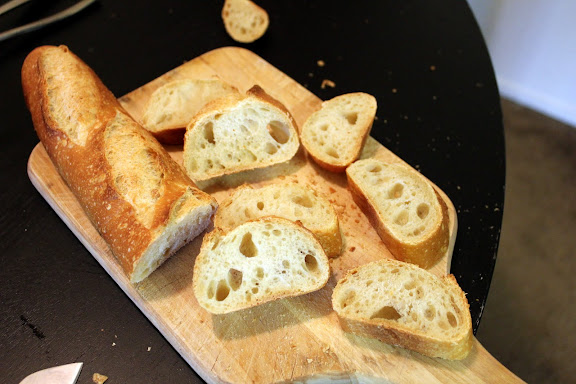Last sunday we went over to my mom's for a mother's day brunch with the family. My mom asked me to "just take a baguette out of the freezer". You know, since baking a batch of bread in time to leave for a 11am brunch (we live about an hour away) would be tricky. The problem? No baguettes in the freezer--we've run through them all since I finished up my baguette quest.
A challenge! This presented a great opportunity to experiment with cold retardation with my standard baguette recipe, Hamelman's Baguettes with Poolish, as well as test just how well they keep at room temperature. Here's what I did:
I mixed a batch of baguette dough around 2 in the afternoon. I then shapped 3 small baguettes a little after 5pm, and set to proofing on a couche. However, for one of the 3 I put a small sheet of parchment underneath. After 40 minutes of proofing, I slid the baguette on parchment off of the couche to finish proofing, while the couche itself with the other 2 baguettes was slid onto a sheet pan and stuck in the refrigerator. The lone baguette was baked when fully proofed, about 75 minutes total. Once it was cool, the baguette was placed in a plastic bag that was not fully sealed, and then wrapped in a paper market bag.
Later, at 10:30, I pulled the couche out of the fridge, flipped one of the baguettes onto parchment on a peel, and baked it immediately, while the other went back into the fridge. Baguette #2 sat on the cooling rack all night, unwrapped (mainly because it was past 11 by then!)
The next morning, the last baguette was baked at 9:30am and taken straight from the oven into a paper bag as we hurried out the door at little after 10.
The results:
From Left to Right: Not retarded, Retarded 4 hours, Retarded 15 hours.

The baguette retarded overnight had lots of bubble in the crust, which made it very crisp and crackly. All three had similar (good) flavor, and seemed plenty moist inside. The baguette not retarded was crisped in the oven before cutting, but I presume it was crisp when fresh. The baguette retarded for 4 hours was rather chewy when we got to it (we took that one home and my wife and I ate it for dinner), about 20 hours after baking.
Crumb shots:
Retarded overnight

Not Retarded

Retarded 4 hours

Longer retarding seemed to be correlated with a lower profile, with the non-retarded baguette being the most round (although the baguettes were sliced on the bias, and were less flat than the slices indicate). I don't think this was underproofing, as the grigne looks pretty clean on those baguettes. The retarded baguettes were much easier to score than the one that had not been retarded.
Conclusion: Retarding baguettes gives a distinctive bubbly crust (for better or for worse), and makes them easier to score, but results in a lower profile. Flavor is about the same either way. As long as the crust is re-crisped, a baguette can sit un-cut at room temperature overnight and be nearly as good as first baked, and as good or better than frozen and thawed. Interesting.




